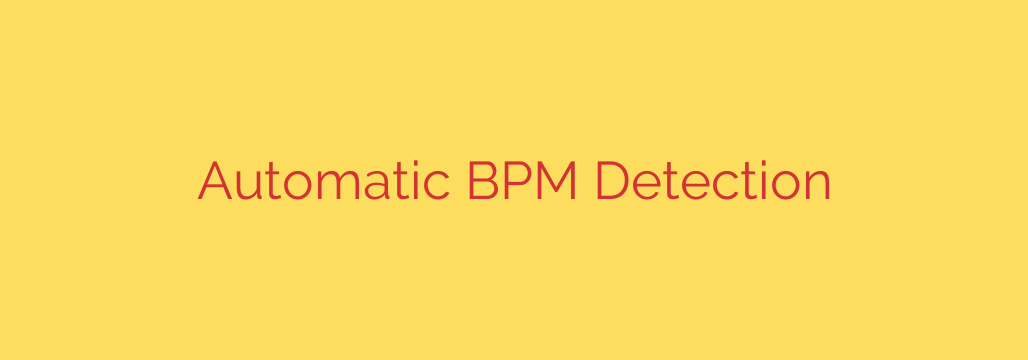
Unlocking the Beat: A Deep Dive into Automatic BPM Detection
Music has a pulse, an inherent rhythm that makes us want to tap our feet, nod our heads, or get up and dance. This pulse is measured in Beats Per Minute (BPM), a simple metric that defines the tempo of a track. For decades, determining a song’s BPM was a manual task for musicians and DJs. Today, sophisticated algorithms can do it in seconds. This is the world of automatic BPM detection—a technology that has fundamentally changed how we create, mix, and even discover music.
But how does a machine “listen” to a song and calculate its tempo? The process is a fascinating blend of audio analysis and pattern recognition.
How Algorithms Find the Rhythm
At its core, automatic BPM detection is about identifying a repeating rhythmic pattern. Software can’t feel the music, so it relies on data to find the “heartbeat” of a song. The process generally involves a few key steps:
Audio Signal Analysis: The algorithm first analyzes the raw audio waveform of a song. It looks for sudden, sharp increases in volume or energy. These moments, known as transients or onsets, often correspond to percussive hits like a kick drum, snare, or clap—the very sounds that anchor a song’s rhythm.
Onset Detection: The primary goal is to create a list of all the potential beat markers in the track. This process, called onset detection, is crucial. In a simple house track with a “four-on-the-floor” beat, finding these onsets is relatively straightforward. However, in a complex jazz piece or a dense rock song, distinguishing the main beat from other musical elements is much more challenging.
Identifying Periodicity: Once the software has a map of potential beats, it searches for a repeating pattern. It measures the time intervals between consecutive onsets, looking for the most common interval. This recurring time gap is assumed to be the time between individual beats.
Calculating the BPM: Finally, the algorithm converts this time interval into a BPM value. For example, if it determines that the primary beats occur every 0.5 seconds, it calculates that there are 120 of these beats in a 60-second minute, resulting in a tempo of 120 BPM.
Why BPM Detection is a Game-Changer
This automated process isn’t just a technical novelty; it has practical applications that empower creators and listeners alike.
For DJs and Music Producers: Automatic BPM detection is the backbone of modern DJ software. It allows for seamless beatmatching, where two tracks are synchronized to the same tempo for smooth transitions. For producers, it instantly aligns samples, loops, and recordings to a project’s grid, dramatically speeding up the creative workflow.
For Music Streaming Services: Platforms like Spotify and Apple Music use BPM data to curate playlists tailored to specific activities. A “Workout” playlist will be filled with high-BPM tracks to keep your energy up, while a “Focus” or “Chill” playlist will feature slower, lower-BPM music.
For Fitness and Gaming: Many fitness apps synchronize workout routines to the beat of the music, creating a more immersive and motivating experience. Similarly, rhythm-based video games rely on precise BPM data to function correctly.
The Challenges: When Algorithms Miss the Beat
As powerful as it is, automatic BPM detection isn’t flawless. Certain types of music can easily confuse even the most advanced algorithms, leading to inaccurate readings.
The Octave Error: The most common mistake is detecting the tempo at double or half its actual speed. For example, a 75 BPM ballad might be misread as a 150 BPM dance track if the algorithm focuses on eighth-note subdivisions instead of the main quarter-note beat.
Complex Rhythms: Music with heavy syncopation, triplets, or unconventional time signatures can throw algorithms off. The software might struggle to find a consistent, repeating pulse when the rhythm is intentionally off-beat.
Varying Tempos: Songs that don’t maintain a steady tempo—like those with a gradual speed-up (accelerando) or slowdown (ritardando)—present a significant challenge. Most detectors provide a single average BPM, which doesn’t capture these dynamic changes.
Ambiguous Percussion: Genres like ambient, classical, or certain types of folk music may lack a strong, clear percussive element for the algorithm to lock onto, often resulting in failed or incorrect detection.
Tips for Accurate Tempo Detection
If you rely on BPM detection for your creative work, there are ways to ensure you get the most accurate results.
Always Double-Check: Never assume the detected BPM is 100% correct. Listen to the track and use a tap tempo feature in your software to manually verify the reading. If it feels too fast or slow, try doubling or halving the number.
Analyze High-Quality Audio: Compressed, low-quality audio files can obscure the transients that algorithms need to identify beats. Always use the highest quality source file available for analysis.
Isolate a Rhythmic Section: If a song has a long, beatless intro or a highly complex section, try analyzing a cleaner, more rhythmically straightforward part of the track, like the main chorus or verse.
Ultimately, automatic BPM detection is a powerful tool that bridges the gap between human musicality and machine precision. While it may never fully replace the trained ear of a musician, it provides an incredible starting point, saving countless hours and opening up new creative possibilities for artists and music lovers around the world.
Source: https://www.linuxlinks.com/bpm-detect-automatic-bpm-detection-tool/








